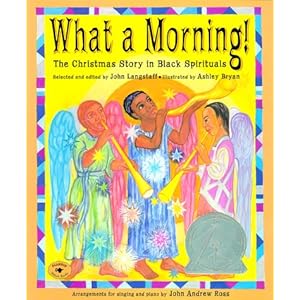 My favorite ornaments on our Christmas tree, which we just took down this week (following my husband's family's tradition, we put it up on Christmas Eve), are a lovely collection of multiracial angels which I've gathered or made over the years.
My favorite ornaments on our Christmas tree, which we just took down this week (following my husband's family's tradition, we put it up on Christmas Eve), are a lovely collection of multiracial angels which I've gathered or made over the years. Why are angels so often depicted as exclusively blonde and fair-skinned? Of all symbols, surely angels should reflect the glorious range of human skin tones and features.




photo by Hannah Dunphy, angel by me
The same is true for books about the holiday. From angels to Santa to depictions of the Holy Family, all of our children should be able to see themselves in the images, but I'd be willing to bet that Christmas picture books as a whole are even less diverse than the rest of children's literature. Christmas is celebrated by Christians of all races and ethnicities, as well as by many non-Christians who enjoy its beauty and rituals. Why should a holiday that is observed the world over have an all-white cast?
In December, my friend and fellow blogger Cat, at Mama C and the Boys, linked to this great post, "Christmas Books for Our Multiracial Family", with a fine list of books.
Here's a few I'd add:
Ashley Bryan's brilliantly colored illustrations look like stained glass, with a black Holy Family and multiracial angels.
Canadian painter William Kurelek depicts a series of dream images in which Mary and the Christ Child appear as Huron Indians, as a black family at a soup kitchen, as seal hunters in an igloo, among cowboys, fisherman, and farmers, in box cars, barns and garages.
Gary Soto tells an everyday story of a modern Latino family at Christmas, with deeply colored, expressive illustrations by Ed Martinez.
Barbara Cooney illustrates a lively Aztec version of the Christmas story, complete with cultural details and beautiful brown angels.
If you observe Christmas, and especially it you share the holiday's traditions with children through books, why not spend the next year adding more color to your collection?




6 comments:
I understand and agree with your point that if we're going to use representational imagery, we shouldn't stick to an all-white cast, but why do we need the cast to look like us in the first place? I'm African American, but I don't need a "black" cast in order to connect to the nativity story. To me that shows prejudice. I'd prefer it if depicting the cast as Middle Eastern Jewish people from the proper time period became the norm.
Thanks, C.
It seems to me there are two valid approaches:
1. Historically accurate Middle Eastern depictions of the nativity focus on what people might have actually looked like.
2. To me, imaginative, racially varied depictions emphasize the inclusiveness of the story: we are all one family, so the divine could take human form in any color. I don't think that's so much about "matching," but about conveying the universality of Love.
Growing up in Korea among devout Christians, I saw hundreds of images of Jesus - always light-skinned and light-haired. The problem I see is that re-casting the story with all-white characters has so become the norm that many children may never see any other possibilities.
Yeah, I agree that both approaches are valid and that it doesn't matter what color Jesus is in human form, but I think starting with a greater emphasis on historically accurate depictions would be more helpful because of the white standard that's already been established.
Since people think of the Italian Jesus as the authentic version, many fail to recognize this depiction as just another interpretation. I have no problem with the varied depictions themselves. It's just that sadly, if someone who isn't say, Korean for example, sees an image of a Korean Jesus, they'll think of it as being only for Koreans but still think of the European depiction as the Jesus for everyone.
I think if we could establish the historical Jesus as the default in societies that have made white the standard, it might bring more attention to how that standard affects our perceptions. Then more people might be receptive to the other varied depictions like the examples you've shown, regardless of whether that depiction looks like them. Thanks for sharing those, by the way!
Wow great discussion in the comments! I have always searched for books where Jesus looks Middle Eastern or some other darker skinned ethnicity for both the reasons of establishing the probably historical look of the "real" Jesus for my kids and making the story universal for them and all of us.
My favorite Christmas book has got to be Margaret Wise Brown's "A Child is Born" illustrated by Floyd Cooper. I also really like "Room for a Little One" by Martin Waddell, illustrated by Jason Cockcroft. Both have stunning non-white cast characters.
Hi, just wanted to say, great post over at White Privilege. Really enjoyed the perspective and frame of reference!
Thanks so much, @jonyang.
The link for that website is:
http://whitepriv.blogspot.com/
Post a Comment